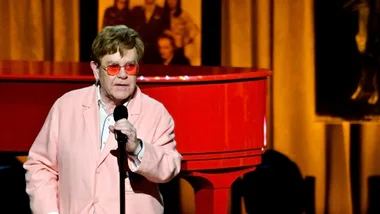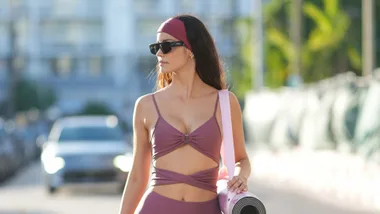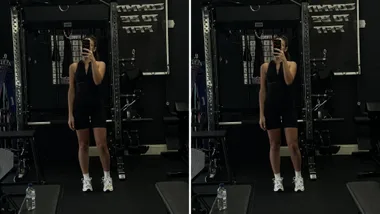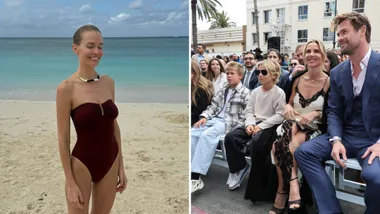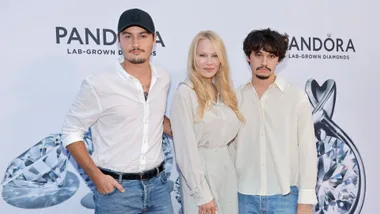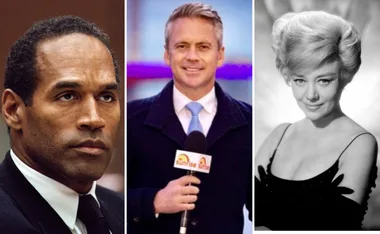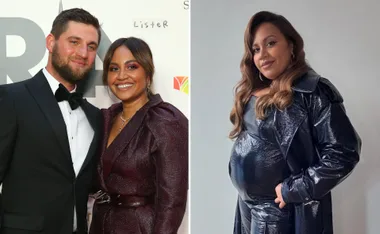Materials: 20 Patons 3 ply Baby Wool 25g balls (quantity is approximate as it varies between knitters); 1 set 3.25 (No. 10) and 3.25 (No. 10) Milward circular needles (various lengths), or size needed to give correct tension; Milward knitters needle for finishing; 3.00 (No. 10-11) Milward crochet book.
Measurement: (approx) 130cm in diameter.
Tension: 31 sts to 10cm in width over stocking st.
Abbreviations: Y fwd, yarn forward; “M3”, (k 1, p 1, k 1) all into next st; sl, slip; psso, pass slipped stitch over; “M 2”, (k 1, p 1) into next st; tbl, through back of loop; “M 5”, (k 1, p 1, k 1, p 1, k 1) all into next st; dc, double crochet.
Cast on 10 sts – (3, 3, 4)
1st Rnd: Y fwd, k 1, rep from to end.
2nd Rnd: Knit.
3rd Rnd: Y fwd, k 2 tog, rep from to end.
4th Rnd: “M 3”, k 1, rep from to end.
Knit 4 rnds.
9th Rnd: As 3rd rnd.
10th Rnd: As 4th rnd.
Knit 6 rnds.
17th Rnd: K 1, y fwd, k 2, y fwd, k 1, rep from to end.
18th Rnd: K1, “M 2”, k 2, “M 2”, k 1, rep from to end.
19th Rnd: K 2 tog, y fwd, sl 1, k 1, psso, rep from to end.
20th Rnd: As 18th rnd.
Rep 19th and 20th rnds 3 times.
27th Rnd: As 19th rnd.
Note: When number of sts will no longer fit comfortably on set of needles, it will be necessary to change to circular needle.
28th Rnd: K 1, “M 5”, k 2, “M 5”, k 1, rep from to end.
Knit 2 rnds.
31st Rnd: Y fwd, sl 1, k 1, psso, k 10, k 2 tog, rep from to end.
32nd and Alt Rnds: Knit.
33rd Rnd: Y fwd, k 1 tbl, y fwd, sl 1, k 1, psso, k 8, k 2 tog, rep from to end.
35th Rnd: K 1, y fwd, k 1 tbl, y fwd, k 1, sl 1, k 1, psso, k 6, k 2 tog, rep from to end.
37th Rnd: K 2, y fwd, k 1 tbl, y fwd, k 2, sl 1, k 1, psso, k 4, k 2 tog, rep from end.
39th Rnd: K 3, y fwd, k 1 tbl, y fwd, k 3, sl 1, k 1, psso, k 2, k 2 tog, rep from to end.
41st Rnd: k 4, y fwd, k 1 tbl, y fwd, k 4, sl 2, k 2 tog, psso, rep from to end.
43rd Rnd: K 5, y fwd, k 1 tbl, y fwd, rep from to end.
45th Rnd: Sl 1, k 1, psso, k 9, k 2 tog, k 1, y fwd, k 1 tbl, y fwd, k 1, rep from to end.
47th Rnd: Sl 1, k 1, psso, k 7, k 2 tog, k 2, y fwd, k 1 tbl, y fwd, k 2, rep from to end.
49th Rnd: Sl 1, k 1, psso, k 5, k 2 tog, k 3, y fwd, k 1 tbl, y fwd, k 3, rep from to end.
51st Rnd: Sl 1, k 1, psso, k 3, k 2 tog, k 4, y fwd, k 1 tbl, y fwd, k 4, rep from to end.
53rd Rnd: Sl 1, k 1, psso, k 1, k 2 tog, k 5, y fwd, k 1 tbl, y fwd, k 5, rep from to end.
55th Rnd: Sl 1, k 2 tog, psso, k 6, y fwd, k 1, tbl, y fwd, k 6, rep from to end.
57th Rnd: Y fwd, k 1 tbl, y fwd, sl 1, k 1, psso, k 11, k 2 tog, rep from to end.
59th Rnd: Y fwd, k 3, y fwd, sl 1, k 1, psso, k 9, k 2 tog, rep from to end.
61st Rnd: Y fwd, k 1, y fwd, sl 1, k 2 tog, psso, y fwd, k 1, y fwd, sl 1, k 1, psso, k 7, k 2 tog, rep from to end.
63rd Rnd: Y fwd, k 3, y fwd, k 1 tbl, y fwd, k 3, y fwd, sl 1, k 1, psso, k 5, k 2 tog, rep from to end.
65th Rnd: Y fwd, k 1, (y fwd, sl 1, k 2 tog, psso) 3 times, y fwd, k 1, y fwd, sl 1, k 1, psso, k 3, k 2 tog, rep from to end.
67th Rnd: (Y fwd, k 3, y fwd, k 1 tbl) twice, y fwd, k 3, y fwd, sl 1, k 1, psso, k 1, k 2 tog, rep from to end.
69th Rnd: y fwd, k 1, (y fwd, sl 1, k 2 tog, psso) 5 times, y fwd, k 1, y fwd, sl 1, k 2 tog, psso, rep from to end.
71st Rnd: K 3, y fwd, k 1 tbl, y fwd, rep from to end.
73rd Rnd: Sl 1, k 2 tog, psso, y fwd, rep from to end.
75th Rnd: Y fwd, k 1 tbl, y fwd, k 3, rep from to end.
77th Rnd: Y fwd, sl 1, k 2 tog, psso, rep from to end.
Rep last 8 rounds twice, ending with a 77th rnd.
94th Rnd: “M 3”, k 1, rep from to end – 640 sts.
Knit 2 rnds.
97th Rnd: K 14, K 2 tog, y fwd, rep from to end.
98th and Alt Rnds: Knit.
99th Rnd: Sl 1, k 1, psso, K 11, k 2 tog, y fwd, k 1 tbl, y fwd, rep from to end.
101st Rnd: Sl 1, k 1, psso, k 9, k 2 tog, k 1 , y fwd, k 1 tbl, y fwd, k 1, rep from to end.
103rd Rnd: Sl 1, k 1, psso, k 7, k 2 tog, k 2, y fwd, k 1 tbl, y fwd, k 2, rep from to end.
105th Rnd: Sl 1, k 1, psso, k 5, k 2 tog, k 3, y fwd, k 1 tbl, y fwd, k 3, rep from to end.
107th Rnd: Sl 1, k 1, psso, k 3, k 2 tog, k 4, y fwd, k 1 tbl, y fwd, k 4, rep from to end.
109th Rnd: Sl 1, k 1, psso, k 1, k 2 tog, k 5, y fwd, k 1 tbl, y fwd, k 5, rep from to end.
111th Rnd: Sl 1, k 2 tog, psso, k 6, y fwd, k 1 tbl, y fwd, k 6, rep from to end.
113th Rnd: Y fwd, k 1 tbl, y fwd, k 7, rep from to end.
115th Rnd: K 1, y fwd, k 1 tbl, y fwd, k 1, sl 1, k 1, psso, k 13, k 2 tog, rep from to end.
117th Rnd: K 2, y fwd, k 1 tbl, y fwd, k 2, sl 1, k 1, psso, k 11, k 2 tog, rep from to end.
119th Rnd: K 3, y fwd, k 1 tbl, y fwd, k 3, sl 1, k 1, psso, k 9, k 2 tog, rep from to end.
121st Rnd: K 4, y fwd, k 1 tbl, y fwd, k 4, sl 1, k 1, psso, k 7, k 2 tog, rep from to end.
123rd Rnd: K 5, y fwd, k 1 tbl, y fwd, k 5, sl 1, k 1, psso, k 5, k 2 tog, rep from to end.
125th Rnd: K 6, y fwd, k 1 tbl, y fwd, k 6, sl 1, k 1, psso, k 3, k 2 tog, rep from to end.
127th Rnd: K 7, y fwd, k 1 tbl, y fwd, k 7, sl 1, k 1, psso, k 1, k 2 tog, rep from to end.
129th Rnd: K8, y fwd, k 1, tbl, y fwd, k 8, y fwd, sl 1, k 2 tog, psso, y fwd, rep from to end.
131st Rnd: Sl 1, k 1, psso, k 15, k 2 tog, y fwd, k 1, “M 2”, k 1, y fwd, rep from to end.
133rd Rnd: Sl 1, k 1, psso, k 13, k 2 tog, y fwd, k 6, y fwd, rep from to end.
135th Rnd: Sl 1, k 1, psso, k 11, k 2 tog, y fwd, k 2, (“M 2”) 4 times, k 2, y fwd, rep from to end.
137th Rnd: Sl 1, k 1, psso, k 9, k 2 tog, y fwd, k 2 tog, k 1, y fwd, (y fwd, k 2, y fwd) 4 times, y fwd, k 1, sl 1, k 1, psso, y fwd, rep from to end.
138th and Alt Rnds: Knit, purling into second loop with two “y fwds” lie tog.
139th Rnd: Sl 1, k 1, psso, k 7, k 2 tog, (y fwd, sl 1, k 1, psso, k 2 tog, y fwd) 6 times, rep from to end.
141st Rnd: Sl 1, K 1, psso, k 5, k 2 tog, y fwd, sl 1, k 1, psso, k 2 tog, y fwd) 6 times , rep from to end.
143rd Rnd: Sl 1, k 1, psso, k 3, k 2 tog, (y fwd, sl 1, k 1, psso, k 2 tog, y fwd) 6 times, rep from to end.
145th Rnd: Sl 1, k 1, psso, k 1, k 2 tog, (y fwd, sl 1, k 1, psso, k 2 tog, y fwd) 6 times, rep from to end.
147th Rnd: Y fwd, sl 1, k 2 tog, psso, y fwd, (y fwd, sl 1, k 1, psso, k 2 tog, y fwd) 6 times, rep from to end – 1080 sts.
148th Rnd: Knit.
Rep 147th and 148th rnds 14 times, dec 8 sts evenly spaced around last round – 1072 sts. Repeat rnds 97 to 148 incl once. Cast off loosely.
BONNET
Using 3.25 needles, cast on 86 sts.
1st Row: K 8, yfwd, sl 1, k 1, psso, rep from to last 6 sts, p 6.
2nd Row: P 8, yrn, p 2 tog, rep from to last 6 sts, p 6.
Rep 1st and 2nd rows 23 times.
Shape Crown: 1st Row: Working in st-st, k 6, k 2 tog, k 8, rep from to end.
2nd and Alt Rows: Purl.
3rd Row: K 6 k 2 tog, k 7, rep from to end.
5th Row: K 6, K 2 tog, k 6, rep form to end.
Cont dec in this manner in alt rows until 14 sts rem. Next Row: Purl.
Break off yarn, thread end through rem sts, draw up and fasten off securely.
MAKE UP
With a slightly damp cloth and warm iron, press lightly. Join crown seam. With right side facing work 1 row dc, then 1 row picots as for dress, evenly around edge. Fasten off. Attach ribbon ties. Press seam.
BOOTEES
Using 2.75 needles, cast on 46 sts.
Work 18 rows as patten for bonnet.
Next Row: K 2 tog, yfwd, k 2 tog, rep from to end – 45sts.
Next Row: Purl.
Shape for Foot: 1st Row: K 29, turn.
2nd Row: P 13, turn.
Work 24 rows st st on these 13 sts. Break off yarn. Rejoin yarn to where first 16 sts were left, knit up 13 sts along side of instep, k 13 toe sts, knit up 13 sts along other side of instep, k 16 – 71 sts.
Knit 13 rows, dec 3 sts evenly across last row – 68 sts.
Shape Foot: 1st Row: (K 2 tog, k 30, k 2 tog) twice.
2nd Row: K 30, (k 2 tog) twice, k 30.
3rd Row: (K 2 tog, k 27, k 2 tog) twice.
4th Row: K 27, (k 2 tog) twice, k 27
5th Row: (K 2 tog, k 24, k 2 tog) twice.
6th Row: K 24, (k2 tog) twice, k 24. Cast off.
MAKE UP
With a slightly damp cloth and warm iron, press lightly. Join leg and foot seams. With right side facing work 1 row dc then 1 row picots as for dress evenly around top edge. Fasten off. Thread ribbon around ankles leaving ends to tie. Press seams.
Newsletter conversion description. Get the latest in your inbox.
